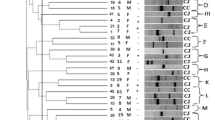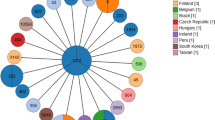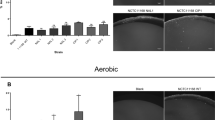Abstract
Campylobacter jejuni has recently been noted as the most common cause of bacterial food-borne diseases in Japan. In this study, we examined in vitro susceptibility to 36 antimicrobial agents of 109 strains of C. jejuni and C. coli isolated from chickens and patients with enteritis or Guillain–Barré syndrome from 1996 to 2009. Among these agents, carbapenems (imipenem, meropenem, panipenem, and biapenem) showed the greatest activity [minimal inhibitory concentration (MIC)90, 0.03–0.125 μg/ml]. This was followed by sitafloxacin (MIC90, 0.25 μg/ml), furazolidone and azithromycin (MIC90, 0.5 μg/ml), gentamicin and clindamycin (MIC90, 1 μg/ml), and clavulanic acid (β-lactamase inhibitor; MIC90, 2 μg/ml). All or most strains were resistant to aztreonam, sulfamethoxazole, and trimethoprim. Marked resistance was also observed for levofloxacin and tetracyclines. Resistance was not present for macrolides and rare for clindamycin. C. jejuni (and C. coli) exhibited high swimming motility and possessed a unique end-side (cup-like) structure at both ends, in contrast to Helicobacter pylori and Vibrio cholerae O1 and O139. The morphology of C. jejuni (and C. coli) changed drastically after exposure to imipenem (coccoid formation), meropenem (bulking and slight elongation), and sitafloxacin (marked elongation), and exhibited reduced motility. In the HEp-2 cell adherence model, unusually elongated bacteria were also observed for sitafloxacin. The data suggest that although resistance to antimicrobial agents (e.g., levofloxacin) has continuously been noted, carbapenems, sitafloxacin, and others such as β-lactamase inhibitors alone showed good in vitro activity and that C. jejuni (and C. coli) demonstrated a unique ultrastructural nature related to high swimming motility and drug action.




Similar content being viewed by others
References
Allos BM. Campylobacter jejuni infections: update on emerging issues and trends. Clin Infect Dis. 2001;32:1201–6.
Vaillant V, de Valk H, Baron E, Ancelle T, Colin P, Delmas MC, et al. Foodborne infections in France. Foodborne Pathog Dis. 2005;2:221–32.
Centers for Disease Control and Prevention (CDC). Preliminary FoodNet Data on the incidence of infection with pathogens transmitted commonly through food—10 states, 2008. Morb Mortal Wkly Rep 2009;58:333–7.
Jacobs-Reitsma W, Lyhs U, Wagenaar J. Campylobacter in the food supply. In: Nachamkin I, Szymanski CM, Blaser MJ, editors. Campylobacter. 3rd ed. Washington, DC: American Society for Microbiology; 2008. p. 627–44.
Infectious Disease Serveillance Center. Campylobacter enteritis in Japan, 1999–2005. Infectious agents surveillance report 2006;27:167–8.
Lastovica AJ, Allos BM. Clinical significance of Campylobacter and related species other than Campylobacter jejuni and Campylobacter coli. In: Nachamkin I, Szymanski CM, Blaser MJ, editors. Campylobacter. 3rd ed. Washington, DC: American Society for Microbiology; 2008. p. 123–49.
Horrocks SM, Anderson RC, Nisbet DJ, Ricke SC. Incidence and ecology of Campylobacter jejuni and coli in animals. Anaerobe. 2009;15:18–25.
Peterson MC. Clinical aspects of Campylobacter jejuni infections in adults. West J Med. 1994;161:148–52.
Blaser MJ, Engberg J. Clinical aspects of Campylobacter jejuni and Campylobacter coli infections. In: Nachamkin I, Szymanski CM, Blaser MJ, editors. Campylobacter. 3rd ed. Washington, DC: American Society for Microbiology; 2008. p. 99–121.
Islam Z, van Belkum A, Cody AJ, Tabor H, Jacobs BC, Talukder KA, et al. Campylobacter jejuni HS:23 and Guillain–Barré syndrome, Bangladesh. Emerg Infect Dis. 2009;15:1315–7.
Farnell MB, Donoghue AM, Cole K, Reyes-Herrera I, Blore PJ, Donoghue DJ. Campylobacter susceptibility to ciprofloxacin and corresponding fluoroquinolone concentrations within the gastrointestinal tracts of chickens. J Appl Microbiol. 2005;99:1043–50.
Sonnevend A, Rotimi VO, Kolodziejek J, Usmani A, Nowotny N, Pál T. High level of ciprofloxacin resistance and its molecular background among Campylobacter jejuni strains isolated in the United Arab Emirates. J Med Microbiol. 2006;55:1533–8.
Akasaka T, Kurosaka S, Uchida Y, Tanaka M, Sato K, Hayakawa I. Antibacterial activities and inhibitory effects of sitafloxacin (DU-6859a) and its optical isomers against type II topoisomerases. Antimicrob Agents Chemother. 1998;42:1284–7.
Fujikawa K, Chiba M, Tanaka M, Sato K. In vitro antibacterial actibity of DX-619, a novel des-fluoro(6) quinolone. Antimicrob Agents Chemother. 2005;49:3040–5.
Tsutsui N, Taneike I, Ohara T, Goshi S, Kojio S, Iwakura N, et al. A novel action of the proton pump inhibitor rabeprazole and its thioether derivative against the motility of Helicobacter pylori. Antimicrob Agents Chemother. 2000;44:3069–73.
Clinical and Laboratory Standards Institute. Methods for antimicrobial dilution and disk susceptibility tests for bacteria that grow aerobically; approved standard, 7th edn. M7-A7. Wayne: Clinical and Laboratory Standards Institute; 2006.
Yamamoto T, Wakisaka N, Nakae T. A novel cryohemagglutinin associated with adherence of enteroaggregative Escherichia coli. Infect Immun. 1997;65:3478–84.
Nelson JM, Chiller TM, Powers JH, Angulo FJ. Fluoroquinolone-resistant Campylobacter species and the withdrawal of fluoroquinolones from use in poultry: a public health success story. Clin Infect Dis. 2007;44:977–80.
van de Giessen A, Mazurier SI, Jacobs-Reitsma W, Jansen W, Berkers P, Ritmeester W, et al. Study on the epidemiology and control of Campylobacter jejuni in poultry broiler flocks. Appl Environ Microbiol. 1992;58:1913–7.
Clarke AM, Zemcov SJ. In vitro activity of meropenem against clinical isolates obtained in Canada. J Antimicrob Chemother. 1989;24:47–55.
Lehtopolku M, Hakanen AJ, Siitonen A, Huovinen P, Kotilainen P. In vitro activities of 11 fluoroquinolones against 226 Campylobacter jejuni strains isolated from Finnish patients, with special reference to ciprofloxacin resistance. J Antimicrob Chemother. 2005;56:1134–8.
Horii T, Kimura T, Sato-Kawamura K, Nada T, Shibayama K, Ohta M. beta-Lactamase inhibitors have antibacterial activities against Helicobacter pylori. J Infect Chemother. 1999;5:206–7.
Ikeda K, Ida O, Kimoto K, Takatorige T, Nakanishi N, Tatara K. Effect of early fosfomycin treatment on prevention of hemolytic uremic syndrome accompanying Escherichia coli O157:H7 infection. Clin Nephrol. 1999;52:357–62.
Snelling WJ, Matsuda M, Moore JE, Dooley JS. Campylobacter jejuni. Lett Appl Microbiol. 2005;41:297–302.
Guerry P. Campylobacter flagella: not just for motility. Trends Microbiol. 2007;15:456–61.
Grant CC, Konkel ME, Cieplak W Jr, Tompkins LS. Role of flagella in adherence, internalization, and translocation of Campylobacter jejuni in nonpolarized and polarized epithelial cell cultures. Infect Immun. 1993;61:1764–71.
Horii T, Ichiyama S, Ohta M, Kobayashi M. Relationship between morphological changes and endotoxin release induced by carbapenems in Pseudomonas aeruginosa. J Med Microbiol. 1999;48:309–15.
Elliott TS, Shelton A, Greenwood D. The response of Escherichia coli to ciprofloxacin and norfloxacin. J Med Microbiol. 1987;23:83–8.
Michie KA, Monahan LG, Beech PL, Harry EJ. Trapping of a spiral-like intermediate of the bacterial cytokinetic protein FtsZ. J Bacteriol. 2006;188:1680–90.
Acknowledgments
We thank Kouji Matsuda (Banyu Pharmaceutical Co., Ltd., Tokyo; 2006) and Hiroko Kanda (Daiichi Sankyo Co., Ltd., Tokyo) for helpful discussion and encouragement in this study.
Author information
Authors and Affiliations
Corresponding author
About this article
Cite this article
Yabe, S., Higuchi, W., Takano, T. et al. In vitro susceptibility to antimicrobial agents and ultrastructural characteristics related to swimming motility and drug action in Campylobacter jejuni and C. coli . J Infect Chemother 16, 174–185 (2010). https://doi.org/10.1007/s10156-010-0040-1
Received:
Accepted:
Published:
Issue Date:
DOI: https://doi.org/10.1007/s10156-010-0040-1




